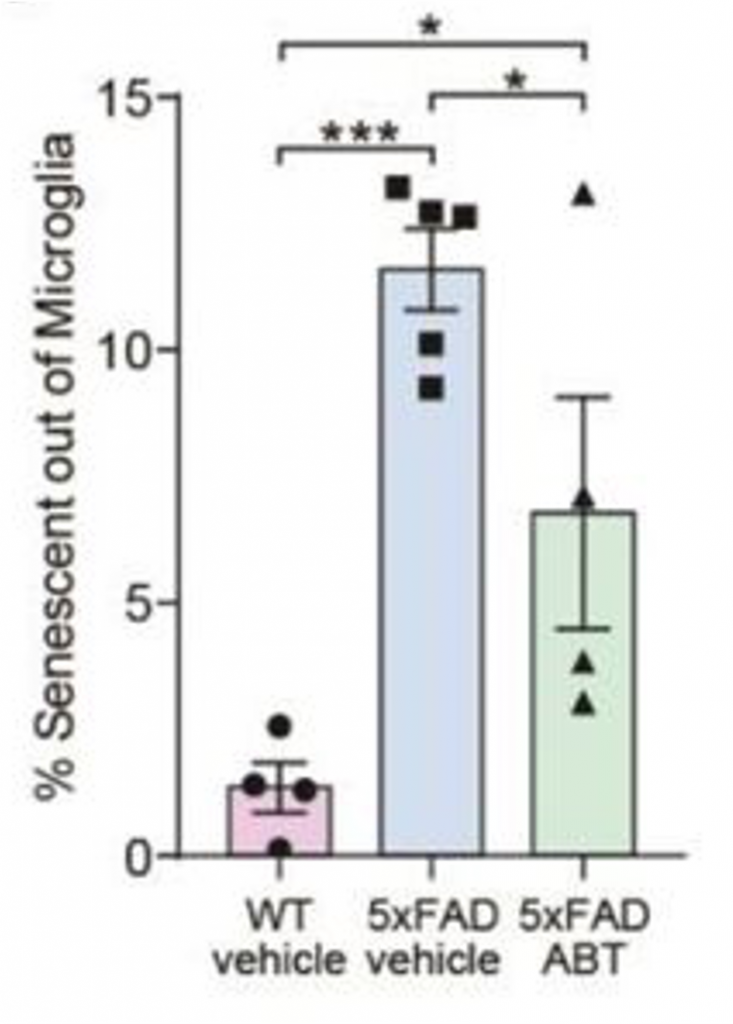Key Points:
- ABT-737 prevents memory loss in Alzheimer’s mice.
- Senescent microglia are nearly halved by ABT-737.
- Brain inflammation is reduced by ABT-737 treatment.
Our immune system supports our brain’s ability to remember past experiences. However, it falters with age, potentially contributing to Alzheimer’s disease (AD), a disorder characterized by memory loss. Such a declining immune system may allow for the accumulation of senescent cells, which promote chronic inflammation. Therefore, senolytics — compounds that selectively destroy senescent cells — may alleviate AD pathology by mitigating brain inflammation.
As published on the preprint (not yet peer-reviewed) server for biology, BioRxiv, Rachmian and colleagues show that the senolytic ABT-737 prevents memory loss in Alzheimer’s mice. They also show that ABT-737 removes senescent brain immune cells called microglia and reduces inflammatory markers in the brain. These findings suggest that the right senolytics could potentially be used to treat AD progression.
Senolytic Drug ABT-737 Prevents Aspects of Alzheimer’s
Most cases of AD are sporadic with the precise cause being unknown. However, a small percentage of AD cases are inherited. The 5xFAD mouse model for inherited (familial) AD is genetically modified to express human genes with 5 mutations (5x) linked to familial AD (FAD). To determine the effects of ABT-737 on AD, Rachmian and colleagues injected 5xFAD mice with either 25 mg/kg/day of ABT-737 or a solution without ABT-737, called a vehicle, for comparison.
We all have different forms of memory, including recognition memory — the ability to recognize previously encountered experiences. The researchers tested recognition memory with the Novel Object Recognition (NOR) test, which measures the duration of time mice spend exploring new objects over familiar, previously experienced, presumably recognizable objects.
It was found that 5xFAD (vehicle-treated) mice explore familiar objects more often than new objects, suggesting poor memory of previously experienced objects. However, ABT-737 5xFAD mice spend more time exploring new objects than old ones, similar to normal mice. These findings indicate that ABT-737 can prevent recognition memory loss in a model for AD.

Following the memory test, Rachmian and colleagues removed the brains from the mice to analyze their microglia. Microglia are the immune cells of the nervous system, able to migrate within the brain to attack pathogens or damaged cells. However, especially with age, these cells can enter a senescent state and secrete pro-inflammatory molecules. Senescent microglia no longer serve as functioning, beneficial immune cells.
The Israeli researchers found that, compared to normal mice, 5xFAD mice had a profound increase in senescent microglia cells. However, 5xFAD mice treated with ABT-737 had about half the amount of senescent microglia cells, suggesting that this senolytic eliminated or prevented the accumulation of senescent microglia. Since senescent cells promote inflammation, these findings suggest that ABT-737 improves memory by destroying senescent microglia and reducing brain inflammation.

To determine if ABT-737 reduces brain inflammation, Rachmian and colleagues measured genes in the brain corresponding to inflammatory proteins called cytokines. One of these cytokines, IL-6, is associated with inflammaging — the age-related rise in inflammation that increases the risk of multiple chronic diseases. The researchers found that 5xFAD mice had more than double the levels of IL-6 than normal mice. However, ABT-737-treated 5xFAD mice had IL-6 levels similar to normal mice, suggesting the prevention and possible restoration of brain inflammation.

Overall, the findings of Rachmian and colleagues demonstrate that ABT-737 improves the memory of AD mice, potentially due to reduced brain inflammation caused by a reduction in senescent microglia. The authors conclude:
“This study suggests that targeting senescent cells may open new potential therapeutic strategies for AD, which might be effective even at late-disease stages.”
Which Senolytics are Safe for Healthy Individuals?
Previous studies have shown that senolytics can mitigate memory loss in naturally aged mice and reduce senescent microglia. Furthermore, an increase in senescent neurons has been observed in post-mortem AD patient brains. In the same study, senolytics were shown to reduce senescent neurons in a human cell model. These studies support the idea that senolytics could potentially prevent or treat AD in humans. Still, Rachmian and colleagues point out that some senolytics have side effects, such as killing healthy cells, and say:
“In the future, developing new senolytic therapies that exclusively target senescent cells, or specifically, senescent microglia, should be considered.”
However, not all senolytics are the same, and ABT-737 is a type of senolytic (BCL-2 family inhibitor) found to be most toxic to normal cells. While their efficacy against AD has not been closely examined, natural senolytics like fisetin and quercetin, especially at lower doses, seem to have fewer side effects. These senolytics can be found in supplement form but also in plant-based foods like strawberries, onions, and grapes. Therefore, the safest option may be to eat more fruits and vegetables.